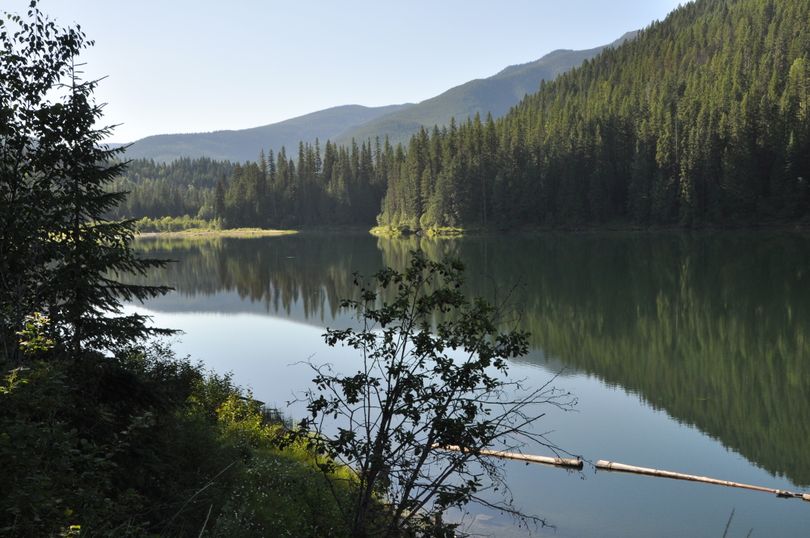OK given to remove Mill Pond Dam from Sullivan Creek

STREAMS -- The Washington Department of Ecology has issued a permit that allows the Pend Oreille County PUD to remove Mill Pond Dam, which is downstream from Sullivan Lake. This long-planned project would improve miles of fisheries habitat.
Another two years of planning will be needed before the work can begin.
Read on for history and details from the Department of Ecology.
The permit is called a "401 Certification," after section 401 in the federal Clean Water Act, and it means work can commence to remove the dam. The permit certifies that water quality will be protected in Sullivan Creek and Outlet Creek while the work is being done.
The Mill Pond Dam is part of the Sullivan Creek Hydroelectric Project, located on Sullivan Lake, Sullivan Creek and Outlet Creek within the Colville National Forest in northern Pend Oreille County. The project is managed by the Public Utility District No. 1 of Pend Oreille County (PUD).
In 2011, the PUD asked Ecology to certify that the proposed removal of the Mill Pond Dam and associated structures and the installation of a cold-water release facility at Sullivan Lake will be done in a way that is safe for the environment.
"This work is planned to improve the environment by restoring the area to its natural state," said Sara Hunt, who manages Ecology's Shorelands and Environmental Assistance Program in Eastern Washington. "But we need to ensure we're protecting that same environment while we're doing the work."
The decision to remove Mill Pond Dam was made by many local, state and federal agencies with the involvement of many people and groups. Taking the dam out will restore Sullivan Creek to much as it was before structures were placed there in the early 1900s.
"The outlook for fish in the stream will be much improved, and people will be able to enjoy the natural mountain stream the way it used to be," Hunt said.
Removing Mill Pond Dam will eliminate the man-made barrier to upstream fish passage, which may help give fish access to 16 miles of new habitat in Sullivan Creek. It also will allow natural sediment to move downstream and improve water quality by cooling the water off substantially. In addition, the removal will enhance natural wetlands. Wetlands are important because they filter and purify water, supply wildlife habitat and control erosion.
The Sullivan Creek Project was built in 1909 by the Inland Portland Cement Co. to supply electricity to Metaline Falls. It consisted of Sullivan Lake Dam, Sullivan Lake, Mill Pond Dam, Mill Pond, an intake structure on Mill Pond, a wooden flume, a canal, a tunnel, and powerhouse. The project was decommissioned in 1956 after a portion of the wooden flume collapsed. Without the flume, water could no longer get to the power house to generate power. Box Canyon Hydroelectric Project was completed in 1956, making repairs at Mill Pond project unnecessary.
The cement company created Mill Pond when it built a log crib dam as part of the project. The concrete Mill Pond Dam, which is 134 feet long and about 55 feet high, was built in 1921 just below the log crib dam. It maintained the water level of Mill Pond at approximately 2,520 feet and changed the stream into a pond.
Mill Pond Dam also altered the natural sediment transport processes in Sullivan Creek by trapping it behind the dam. This means the sediments are depleted in Sullivan Creek, downstream of Mill Pond Dam, removing important spawning gravel for local trout populations.
The dam also raised the water temperatures so it was too warm for a healthy eco-system. Impounding the water in the pond increased by more than 4 ºF the temperature of the water discharged from Mill Pond Dam and flowing towards the mouth of Sullivan Creek. During the summer months, water temperatures can exceed 61 ºF, which is too warm for local species of fish.
Removing Mill Pond Dam will help keep the water cool, but studies also have concluded that a cold-water release facility at Sullivan Lake Dam consisting of a 48-inch-diameter pipe with fish screening at the intake would also help lower temperatures in Outlet and Sullivan creeks during the summer and fall. The 401 Certification concludes that installing this pipe will be done in a way that protects water quality - including fish populations in Sullivan Lake and Outlet and Sullivan creeks.
The PUD will have two years to finish design plans for the work, and the removal can begin after that plan is approved by Ecology, the U.S. Forest Service and the Federal Energy and Regulatory Commission.
